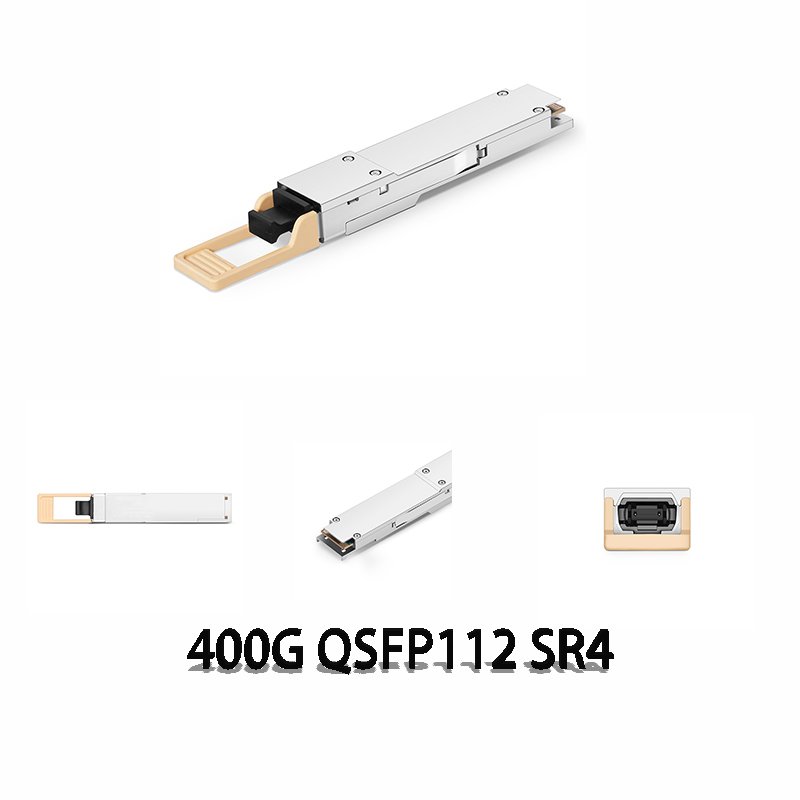As the demand for data centers and network infrastructure continues to increase, so does the need for higher-speed and more efficient data transmission solutions. Against this backdrop, 400G fiber optic transmission technology has emerged as an important technology for large-scale data centers, cloud computing, and high-performance computing. Today, there are several different types of 400G optical modules on the market, including QSFP112 SR4, QDD SR4, and QDD SR8. Although these modules all belong to the 400G transmission standard, there are significant differences in interfaces, bandwidth, and transmission distance. In this paper, we will delve into the main differences between these three modules to help understand their advantages and applicability in different application scenarios.
Table of Contents
Toggle1. 400G QSFP112 VS 400G QDD
1.1. 400G QSFP112 Introduction

QSFP112 (Quad Small Form-factor Pluggable 112) is a new type of fiber optic module package for 400G data transmission. This package form factor enables the optical module to have digital diagnostic monitoring (DDM) and control functions. 400G QSFP112 has four transmission channels, each providing 100Gbps of bandwidth, for a total of 400Gbps. it uses standard QSFP interfaces, fits into most existing fiber optic architectures, and supports transmission over long distances (typically up to 100 meters). The QSFP112 module benefits from its broad compatibility and more mature technology.
Although the QSFP112 SR4 offers very high bandwidth, it has a low individual channel bandwidth (100 Gbps per channel transmission) due to its 4-channel design, which can be a bottleneck in certain applications that require very high bandwidth.
1.2.400G QDD Introduction
The 400G QDD (Quad Density) module was developed to meet the need for higher port density and more compact designs, using a 4-channel design similar to the QSFP112, but with different physical dimensions and connectivity interfaces.The QDD interface is more compact than the QSFP112 interface, providing higher port density and allowing data centers to deploy more fiber optic ports in limited space. fiber optic ports in limited space. And the QDD module not only maintains the 400Gbps transmission rate but also provides more ports to deploy more fiber connections in the same space.
2. QDD SR4 vs QDD SR8
2.1.QDD SR4 Introduction
The QDD SR4 module adopts 4 optical signal channels; each channel transmits 100 Gbps, and the total bandwidth reaches 400 Gbps. SR4 (Short Range 4) means that it is mainly used for short-distance transmission, usually working on multimode fiber, and the maximum transmission distance can reach 100 meters. This module is ideal for high-speed connectivity within data centers, especially in environments requiring high port density and limited space.
2.2. QDD SR8 Introduction
QDD SR8 is another optical module in the QDD series, providing 8 optical signal channels; each channel also transmits 100 Gbps with a total bandwidth of 800 Gbps, which means that the QDD SR8 provides twice as much bandwidth as the QDD SR4, and is able to satisfy the demand for larger-scale data transmission. The QDD SR8 module has the same bandwidth per channel as the QDD SR4, but because of the increase in the number of channels, the overall transmission capacity is much higher.
3.400G QSFP112 SR4 VS QDD SR4 VS QDD SR8 Key Features
Key features of the QSFP112 SR4 include:
- Bandwidth: Supports 400 Gbps high-speed data transmission.
- Number of channels: Uses 4 optical signaling channels.
- Connector: Standard LC connector.
- Transmission Distance: Up to 100 meters on multimode fiber.
QDD SR4 module features:
- Bandwidth: Also supports 400 Gbps high-speed data transmission.
- Number of channels: 4 optical signaling channels are used.
- Connector: QDD standard connector (smaller than QSFP112).
- Transmission distance: Also applicable to multi-mode fiber, transmission distance is 100 meters.
Key features of the QDD SR8 module include:
- Bandwidth: Supports data transmission up to 800 Mbps.
- Number of channels: 8 optical signaling channels are used.
- Connector: QDD standard connector.
- Transmission distance: 100 meters over multimode fiber.
| Feature | QSFP112 SR4 | QDD SR4 | QDD SR8 |
| Bandwidth | 400Gbps | 400Gbps | 800Gbps |
| Channel Count | 4 | 4 | 8 |
| Connector | LC Connector | QDD Connector (More Compact) | QDD Connector (More Compact) |
| Transmission Distance | 100 meters (Multimode Fiber) | 100 meters (Multimode Fiber) | 100 meters (Multimode Fiber) |
| Application | Data Center Short Distance Connectivity | Data Center High-Density Ports | High-Bandwidth, High-Traffic Applications |
Figure 4: 400G QSFP112 SR4 VS QDD SR4 VS QDD SR8
4. Application Scenarios and Selection Recommendations
QSFP112 SR4: Since it usually supports a transmission distance of 100 meters, it is suitable for internal data centers and inter-adjacent rack connections. For traditional large-scale data center architectures, QSFP112 SR4 is a proven choice, especially in applications that require high compatibility and stability, such as cloud computing, storage virtualization, and large-scale databases.
QDD SR4: Its more compact design delivers higher port density for scenarios where space is at a premium but high bandwidth is still required. the QDD SR4 is suitable for high-density data center environments, especially in scenarios where more connectivity ports are required but space is at a premium, such as hyperscale data centers, hosting services, and cloud service provider infrastructures.
QDD SR8: It provides higher bandwidth and is suitable for application scenarios where bandwidth is critical. It has a significant increase in transfer rate and bandwidth compared to QDD SR4, so it can better support large-scale data exchange and high-bandwidth applications, such as big data analytics, AI training, and high-performance computing.
5 Conclusion
Although QSFP112 SR4, QDD SR4, and QDD SR8 modules can all provide more than 400G of bandwidth, their respective channel counts, interface standards, port densities, and transmission capacity differences make them suitable for different network architectures and application requirements. Choosing the right module is not only about bandwidth requirements but also about making decisions based on data center space, connectivity, and future expansion needs.






